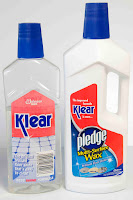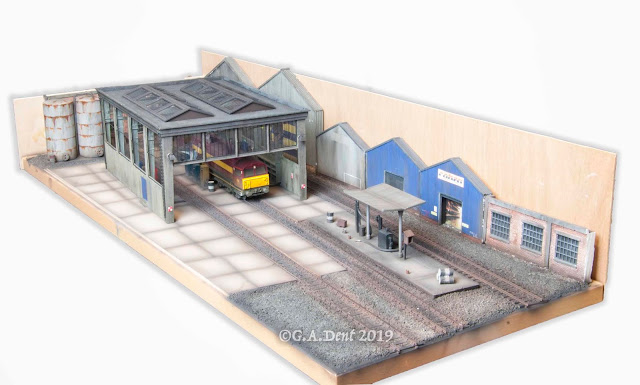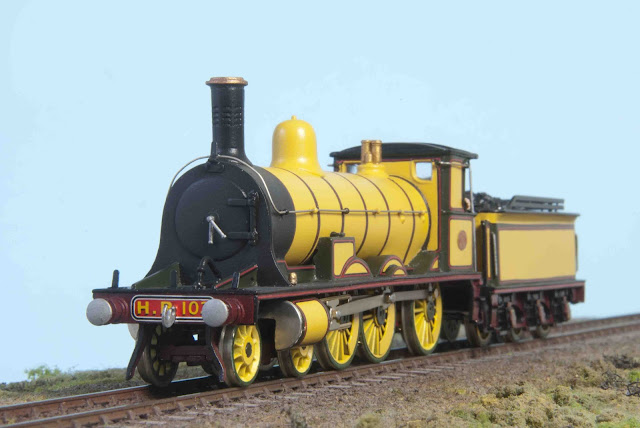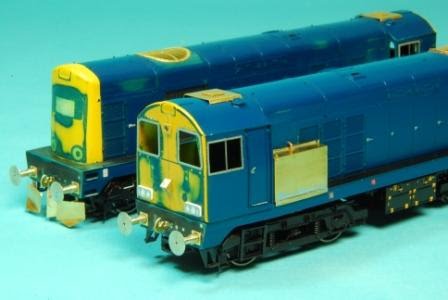KING OF THE STRIPPERS
Vi-Trains bodyshells ready for action.
Had a jolly trip to Model Rail HQ in Peterborough yesterday and, while I was away, I left a couple of Vi-Trains bodyshells 'pickling' in paint stripper. Being a bit wary of dodgy chemicals, I usually just rub down the surface with abrasives - and sometimes a bit of T-Cut - before repainting, but I thought I'd have a go at doing things properly for a change. As the factory finish on Vi-Trains products is usually quite thin, I reckoned it should come off quite easily.
So, with a heavy duty plastic tub and 2 bumper bottles of Phoenix Precision Superstrip, the shells were submerged and left for 24hours out in the safety of a locked shed away from curious pets and spouses. Bright and early this morning, I ventured out in the sub-zero temperatures with a bucket of warm water, gloves and an old toothbrush, extracted the locos and marvelled at how the paint simply dropped away with a very light scrubbing.
It pays to be thorough with the cleaning-up - I used a cream cleanser abrasive cleaner, followed by Flash all-purpose detergent and plenty of clean water changes. Eye goggles and an old jacket are recommended to protect against splashes and make sure you get all the residue out from the grilles, recesses and the inside of the shells. Oh, and dismantle the models completely beforehand as the stripper may loosen any glue bonds, leaving small details to vanish in the vat of stripper; and it will ruin clear glazing.
The Superstrip can be returned to the bottles for re-use or, as I do, left in the plastic tub that has a water-tight lid that is clipped firmly in place and left in a very safe place in the shed. The stuff also works on Hornby and Bachmann models, but usually needs a bit longer - about 2 days, depending on the model and its paint scheme.
But what are these models destined to become? The 37, originally in BR Railfreight 3-tone grey is to undergo a DRS conversion, whilst the 47 is going in reverse: a DRS loco being back-dated to late 1990s BR condition. Both are to act as test-beds for more fabulous detailing parts from Shawplan and PH Designs. Stay tuned for more updates on these later in the year.







Very interesting article, especially as I used Modelstrip for the first time at the weekend (up to now I have used brake fluid with great success).
ReplyDeleteThe problem I encountered was removing all the fixtures and fittings from a Bachmann 47, in particular the marker lights and the cab lighting unit (which are firmly stuck to the inside of the cab roof). Any suggestions or techniques? Regards, Philip
Hi Philip. Tricky items to remove, such as the glazing units, can be really tiresome. Sometimes they're only tacked in position and the glue bond can be broken easily with a sharp knife. However, if the person assembling the model has been over generous with the glue, it can be a nightmare! A number of gentle passes with the knife can still work, being patient and waiting for the bond to weaken gradually.
ReplyDeleteGenerally, though, if a model is proving too awkward to dismantle, I resort to leaving those parts in place and mask them up with tape, Maskol fluid or even Blu-Tack. Using paint stripper is out, so I rub the paintwork down with fine abrasives (Albion Alloys) and clean the model thoroughly before masking up any bits and spraying a few coats of grey primer.
Cheers,
George.
Thanks for your thoughts George, I will give it a try, especially the fine abrasives. I found using the side of the head of a cotton bud very effective at removing the glazing from diesels, especially the body-side glazing. Best regards, Philip
ReplyDelete